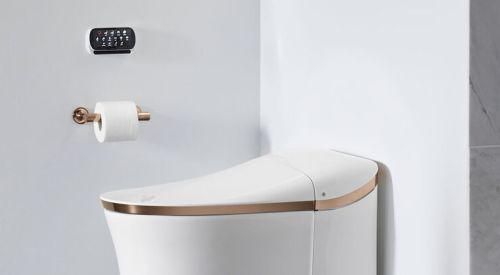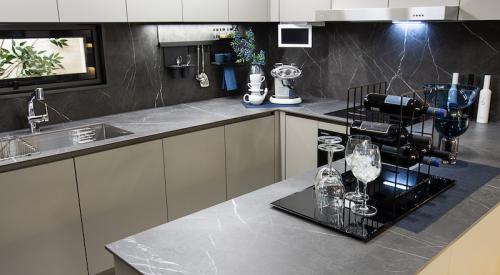Green design has been around long enough for builders and consumers to know that it takes more than just a green label for a product to be eco-friendly, but finding the right options can still be a pain. When it comes to sniffing out safe paints, knowing the off-gassing levels and ingredients of products is key.
What is an eco-friendly paint?
Eco-friendly. Green. Safe. All these vague terms are often thrown around without clear definitions. Though some paints are compostable, eco-friendly usually refers to the home environment rather than the earth when talking about interior paints. These paints focus on increasing indoor air quality by reducing potential off-gassing compared to traditional paints.
“Over the past 10 years, we’ve seen design professionals, homeowners and building codes become more savvy with energy performance metrics,” Stephanie Horowitz, AIA, CPHC, and cofounder of ZeroEnergy Design. “We’re starting to see a similar trend with embodied carbon and indoor air quality. Once a demand and literacy is developed for all of these considerations, energy, carbon, indoor air quality, we’ll be in a much better place.
Real Milk Paint
Biodegradable and compostable, Real Milk Paint is made from organic, non-toxic materials that emits no man-made or natural VOCs. The paint comes in 56 colors and can be used on interior or exterior products with a durable finish. Fun fact: If swallowed, the safety data sheet recommends consulting a physician and giving the person “two 12 oz. glasses of water diluted with vinegar or fruit juice”--far from the usual poison control call.
ZeroEnergy Design, a Boston-based architecture firm, specializes in green and high-performance home building. When it comes to interior designs, they pay special attention when specifying interior paints because the products will affect indoor air quality, while exterior paints have less of a direct impact, according to Horowitz.
What does “Zero VOC” mean and why is it important?
According to Green America (EPA), paint has many ingredients that painters and homeowners should be aware of, including volatile organic compounds (VOCs), fungicides and biocides, and toxic pigments. VOCs, which can give off toxic chemicals in off-gassing, are of special concern when it comes to choosing an eco-friendly paint.
“Many paints contain [VOCs], which refers to a class of chemicals that evaporate readily at room temperature,” Green America says in its guide on eco-friendly paints. “When these VOCs off-gas, a process that can last for weeks depending on the type of paint, they may cause a variety of health problems like nausea; dizziness; irritation of the eyes and respiratory tract; heart, lung, or kidney damage; and even cancer.” Green America also notes that these VOCs do not just pose a risk to maintaining a safe indoor air quality, but they can also escape into the atmosphere and negatively impact the larger environment.
Safecoat
Safecoat Zero VOC Eggshell gives off zero VOCs or hazardous air pollutants. Its formula is made without formaldehyde preservatives and the company says it is ideal for interior spaces where limited chemical exposure is a must such as homes, schools, hospitals, or offices. However, the paint is water soluble and should not be introduced to waterways.
Because of this, builders who are concerned with safe paints will choose zero-VOC or low-VOC paint options. Good clues for finding a good option are any credible labels and certifications a product may have.
“Our preference is to look for zero-VOC paints, preferably with a respected third-party certification such as a Declare Label,” Horowitz says. “The Declare product database can be a great resource because it provides transparency by disclosing what material a product is made of or not made of, where it comes from, and where it’s going at the end of it’s lifespan.”
The Environmental Protection Agency recommends looking for products with reduced or eliminated levels of toxins (ammonia, formaldehyde, crystalline silica, odor masking agents, fungicides) and volatile organic compounds. Builders can also seek out recycled paint, salvaged excess paints, alternative paints (made of lime, milk protein, clay, and earth-based pigments).
Green labels and certifications to look for safe paints
To find quality eco-friendly paints, looking for certifications or green labels can help speed up the process. Here are three that builders can use as a cheat sheet:
- Greenguard Certification: The certification limits the amount of emissions a product can give off and has both a standard and gold level. Gold certification takes high-impact locations such as schools and chemically sensitive individuals into account.
- Declare Label: This label tells a buyer where a product comes from, what it is made of, and where it goes at the end of its life. With the label, builders can check if the product meets the California Department of Public Health (CDPH) Standard Method v1.1-2010 (or international equivalent) for all interior building products that have the potential to emit Volatile Organic Compounds.
- Green Wise: Green Wise Gold certificated products contain less than 5 grams VOC per liter, even after tinting with specified colorants.
Clare
Clare’s water-based interior wall paints are Zero VOC and Greenguard Gold certified. The company says that it is a self-priming, low-odor, and washable paint.
Red flags that may mean the paint isn’t as safe as it sounds
Though knowing VOC levels and credible labels helps, it still can be a struggle to identify sustainable paints at first glance. Some manufacturers try to use vague claims to imply that they are an eco-friendly product when they actually are not.
“There are many buzzwords that don’t necessarily mean anything or are unregulated terms including all natural, eco, biodegradable, plant-base, sustainably harvested,” Horowitz says. “At a minimum level, transparency by the manufacturer is important, as is third-party certification of data and compliance with third-party standards. If you can’t find this credible information, we view that as a red flag.”
If that’s confusing to you, you’re not alone. Reputable companies and even this article uses the terms eco-friendly and sustainable to describe products as they’re familiar and easy to understand. But the important part is context.
“When considering the options available for paints we consider the track record of the product and manufacturer, the health of the people occupying the building, and the health of the greater environment as a result of manufacturing and disposing of it,” Horowitz says. “Benjamin Moore Ultra Spec 500, for example, is a commonly available zero VOC paint that has a Declare label.”
Behr
Though the Premium Plus Interior Semi-Gloss Enamel No. 3050 emits VOCs, its emission rate of less than 0.5 grams per litter qualifies it for Greenguard Gold certification. The paint features an antimicrobial agent that is mildew and mold resistant, and it is both a primer and paint.
Limitations of safe paint standards
Though paint manufacturers have come a long way in terms of creating safer paints, the system isn’t perfect. Jay Watts, vice president of AFM Safecoat, says that meeting regulation is just the first step and advocates for real-life testing for paints to make sure the product is sound on both paper and practice. AFM Safecoat is a paint manufacturer that specializes in products that prioritize indoor air quality.
In the podcast “Non-Toxic Environments with Jay and Andy,” Watts explains how VOC counts only show part of the picture: Some VOCs are worse for humans than others but account for the same count. And other substances that off-gas such as formaldehyde and ammonia that may have looser regulations than other VOCs make their way into even zero-VOC options.
“What negatively affects one person can have no effect on another,” Watts says. “The short answer is look behind the marketing curtain and determine what the company has done in the past and if they have done the real groundwork necessary to make the claims they make.”
Another caveat is that the VOC levels on the can are often based on the base coat without any colorants, which Elemental Green says can add additional VOCs and toxins. Checking the can’s label and researching products before choosing a color can help a builder know what the actual VOC level will be. And due diligence can also reveal even better options than regulation standards.
“Keep in mind that many paints labeled ‘low-VOC’ simply meet the Environmental Protection Agency’s minimum requirements, which call for no more than 250 grams per liter (gm/l) of VOCs in ‘low-VOC’ latex paints and no more than 380 gm/l for ‘low-VOC’ oil-based paints,” Green America says in its paint guide. “There are paints available with even lower VOC levels (0-100 gm/l).” The organization says to check the paint can label or call the company to ask for a material safety data sheet.
Though zero and low-VOC options are the industry standard for now, there is still legwork that builders who want to prioritize indoor air quality must do.
BioShield Paint
Designed for covering brick, plaster, and masonry, BioShield Healthy Living Paints is a collection of solvent-free wall paints that emit zero VOCs. The paints are made mostly of water, chalk, and asbestos-free talc. One gallon can cover roughly 300-400 square feet.
Go Green World Products
Plant-based Agri-Paint, an interior and exterior bio-acrylic paint, emits zero VOCs. Because the company uses raw materials over petroleum-based latex and acrylic resin in its paints, it says it can reduce the VOC emissions even further than EPA-compliant “zero VOCs” standards.
Sherwin-Williams
Besides meeting zero-VOC standards, the Harmony Interior Acrylic Latex paint also features odor- and formaldehyde-reducing technologies which the company says “helps improve indoor air quality by reducing VOCs from possible sources like insulation, carpet, cabinets and fabrics.” The product achieved GREENGUARD Gold Certification and comes in flat, eggshell, and glossy finishes.
Benjamin Moore
Aura Bath and Spa paint is mildew resistant for high-humidity environments, meets zero VOC standards, and is low odor. The interior matte paint is available in thousands of colors and made of a proprietary acrylic formula.
Ecos Paints
Non-toxic, zero-VOC, and odorless, Ecos Interior Chalkboard Paint turns any indoor surface into a chalkboard. The company says that the “low sheen, washable, super-resilient paint” is compatible with any sidewalk chalk.
Valspar
Simplicity meets Zero VOC standards and is Greenguard Gold Certified. However, the company does note that adding colors to the scuff-resistant paint and primer base can increase VOC emissions.
Dunn Edwards
Spartazero is Green Wise certified, meaning it off-gasses less than 5 grams of VOCs per liter. The company says that the paint is durable, low odor, and “uniquely thickens to minimize roller splatter.”













